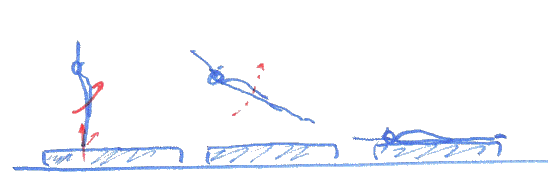Basic Back Landings
Back Bouncing

Starting from a static trampoline laying on your back with your legs and arms upright this is an excellent exercise in its own right but also prepares you for back landings generally. Start the bed moving by trying to push your hips off the bed (keeping legs upright as much as possible) - as you get the timing right you will find that each rebound allows you to push your hips higher until you are bouncing clear of the bed.
Flat Back

A useful intermediate skill before attempting Back Landings this is usually performed on a safety mat. Start in a standing position about one-third of the way into the mat, rock the bed gently and then press down hard with toes at the same time as you extend arms up and lift chest & hips slightly forward - note that although the hips lift up and forward the fingers and toes ought to remain in vertical alignment
Back Landing (or Back Drop)

The back landing (or back drop as it was once known) starts in an upright position with chest & hips pushed slightly forward as you jump upwards (with arms up and fingers still directly above your toes). Extending your arms and legs as much as possible the initial hip displacement causes a small amount of backward somersault rotation – sufficient to allow you to land on your back as the diagram shows. The arms-extended position ought to be maintained throughout; just before landing the legs are raised in an action similar to piking (but not excessively) in preparation for the correct landing position.
If there is a tendency for the back drops to land behind the point of take-off then a useful remedial activity is to revisit seat landing take-offs, encouraging strong vertical direction and then (on a safety mat) tuck in at the last moment before landing on seat to create a small amount of extra rotation to cause a back landing instead. This will give the performer reassurance that they can actually bounce vertically and still rotate.
 ®
®









